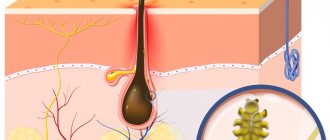Surgeon
Bohyan
Tigran Surenovich
Experience 37 years
Surgeon of the highest category, Doctor of Medical Sciences, member of the International Association of Surgeons, Gastroenterologists and Oncologists
Make an appointment
Lipoma (fat) is a benign formation in the form of small nodules, the appearance of which is associated with the accumulation and compaction of excess adipose tissue. The size of the lipoma may increase or remain stable. When exposed to unfavorable factors, pockets of pathogenic microflora can form inside the wen, which makes it a source of other serious diseases of internal organs. The unaesthetic appearance of formations protruding on the surface of the skin is also important. Therefore, in most cases, a decision is made to remove the tumor and its subsequent histological examination to clarify the nature of the wen - benign or malignant.
The area of localization of lipoma is the back, chest, face, limbs, mammary glands, structure of internal organs. The formation can be detected accidentally during diagnostic procedures or during palpation. The edges of the lipoma are dense and clear, the formation is mobile, and its palpation is painless. It is more difficult to detect a lipoma in the tissues of internal organs. However, it is precisely such cases that are recognized as the most dangerous, threatening disruptions in the functioning of the affected tissue area.
Symptoms, signs, diagnosis of lipoma
Before you remove a wen, you need to make sure that it is exactly that. The shape of the wen formed under the skin is round or oval. It is mobile and soft to the touch; as a rule, no pain is felt when pressing on it.
Fatty deposits located under the skin of the face, neck, back, arms and other parts of the body usually do not cause any symptoms. A lipoma formed on internal organs causes the following symptoms:
- When a lipoma appears in the esophagus, coughing, nausea, and a feeling that there is a foreign body in the throat may occur;
- Chest pain may be the cause of lipoma formation in the mammary gland;
- Symptoms such as headaches, nausea, and vomiting may occur with a lipoma in the brain.
A lipoma is diagnosed visually during a clinical examination; if this is not enough, using ultrasound, x-rays, and computed tomography.
Types of lipomas
There are several main classifications of lipomas that are actively used in medical practice. Depending on the type of tissue that is involved in the pathological process, the following types of neoplasms are distinguished:
- perineural - localized around nerve trunks;
- intermuscular – located between the muscles of the body;
- lumbosacral - grow near the vertebrae or in the spinal canal;
- soft tissues - located on the surface of the skin, less often subcutaneous;
- joints - are located in the synovial membrane or vagina of the joints.
The formation can appear in almost any part of the body and internal organs. Depending on the location of the compaction , the following types of lipomas are most often diagnosed:
- mammary gland - forms in the glandular tissue and deforms the shape of the breast as it grows;
- breasts - a soft and mobile formation that appears in the subcutaneous fatty tissues;
- head - a frequently occurring pathology, which is mainly formed as a result of insufficient hygiene;
- back - one of the most common neoplasms, characterized by extremely slow development;
- neck is a hereditary disease that, during development, can impair the airways, cause weakness and angina.
There are also other, less common places where pathology forms, which include the brain, limbs, skin, peritoneum, eyes, lips and face.
Also, these compactions are divided into two large groups: single and multiple. The first represent a single formation in any part of the body. The latter, accordingly, are characterized by multiple manifestations in different areas of the body and are much less common.
Treatment of wen
Despite the fact that a wen under the skin usually does not cause any inconvenience, many people are interested in how to remove a lipoma . First of all, you should consult a doctor, especially in cases where inflammation of the wen has occurred. Those who are wondering how to squeeze out a wen should know that you should never do this yourself.
Removing wen at home can not only provoke infection into the wound, but also leave unsightly atrophic scars. However, in addition to the medical procedures that a doctor can offer, there are also traditional medicine and pharmaceutical preparations that will help cope with this problem.
By appearance
Based on how the tumor looks, lipomas can be divided into:
- Ring-shaped (location – neck, similar to a necklace);
- Tree-like (located inside the joints);
- Capsule-shaped (with a dense shell and clear edges);
- Diffuse (without capsule, clear boundaries);
- Ossified or petritic (when calcium deposits form inside);
- Pedicled (with a pedicle where the vessel and nerve are located);
- Dense;
- Soft.
The reasons may be as follows:
- Neutrophic;
- Lack of nutrition to the nerves in a certain area.
Lipoma contains fat cells of different sizes. Between the simple fat cells there are rudimentary ones, which affect the growth of the former.
Lipomas grow slowly. With frequent trauma, there is a risk of lipoma malignancy.
When localized superficially, the lipoma looks like a painless, mobile formation ranging in size from 0.5 to several centimeters. Lipoma can be either dense or dough-like. It does not hurt when touched, although it can compress nervous and vascular tissues. If it is located in a vulnerable place, then pus and inflammatory processes may appear from friction.
Most often, this tumor grows on the head, face, neck and waist, back, chest, but can also occur on the legs and abdomen.
The patient will complain of breathing problems if the lipoma is on the neck.
Typically complaints are cosmetic and aesthetic in nature.
During examination, a specialist doctor determines a lipoma by its location (if it is located in a place where adipose tissue accumulates), soft or compacted consistency, mobility, painlessness on palpation, tissue retraction when the skin is stretched.
Next, the puncture is taken for study.
They may prescribe ultrasound, x-rays, electroradiography of soft tissues, contrast x-rays, magnetic resonance and computed tomography.
The doctor must distinguish a lipoma from an atheroma.
You should not treat the problem yourself. After consultation with a surgeon, surgical treatment is prescribed, if required.
Prostate adenoma
How to remove wen using traditional methods
If it is not possible to visit a doctor’s office, you can try to remove the lipoma yourself. But this applies only to those formations that have appeared recently. If the lipoma is old, it needs to be treated only surgically.
Baked onion
Onions are considered one of the most effective means for removing wen. Do the procedure at least 2 times a day.
- Take one medium onion and bake in the oven.
- Grind the cooled onion using a meat grinder.
- Grate baby soap, add to onion and mix thoroughly.
- Apply the resulting mass as a compress to the wen.
Sour cream with honey
Before the procedure, you need to take a hot bath to steam the wen. Then the components of the prepared remedy for wen will better penetrate the adipose tissue of the tumor. Carry out the procedure every other day.
- Mix equal amounts of sour cream, honey and sea salt.
- Apply the resulting mixture to the problem area.
- After 20 minutes, rinse with warm water.
Causes of lipoma
The general pattern of the appearance of wen is the accumulation of fat cells due to a violation of fat metabolism in the body. If measures to treat the problem are not taken in a timely manner, the formation quickly grows, pinching nearby muscles and blood vessels. Among the causes of lipoma that influence the unfavorable course of the pathology, it is worth noting:
- Hormonal disorders, a period of hormonal changes in the body.
- Metabolic failures.
- Disturbances in the diet with a predominance of food of animal origin.
- Diseases of the kidneys and liver, pancreas and thyroid gland.
- Bad habits.
- Diabetes.
- Genetic predisposition.
Also, the formation of excess adipose tissue is affected by physical inactivity, a sedentary lifestyle and refusal of full-fledged physical activity.
Treatment of lipomas with pharmaceutical products
Those who prefer to use pharmaceutical drugs should purchase Vishnevsky ointment. This product should be applied to an adhesive plaster and attached to the affected area, after 2 days the plaster should be replaced with a new one.
You can also use hydrogen peroxide. This drug should be regularly lubricated. After a few days, the skin on the affected area will burst and the contents of the wen will leak out.
lipoma treatment
Treatment methods
The treatment method is selected based on the location of the tumor, size and medical history of the patient. First of all, the doctor must make sure that the patient’s neoplasm is benign. To do this, the doctor carefully examines the patient, collects anamnesis and, if necessary, refers him to the necessary tests. For the differential diagnosis of lipomas, ultrasound examination of soft tissues, computed tomography, magnetic resonance imaging are used and, if a malignant tumor is suspected, a tumor biopsy is taken.
The most common type of tumor from adipose tissue is a subcutaneous lipoma, which does not cause dysfunction of organs, systems and does not threaten the patient’s life, and removal is performed only for cosmetic purposes.
Also, indications for surgical treatment of lipoma are large tumor sizes, 5 cm or more, and the presence of symptoms caused by the tumor.
There is no effective conservative treatment for lipomas. It is also worth noting that traditional methods such as heating and applying ice do not affect tumors from adipose tissue. However, they can cause serious complications if the neoplasm is of a different nature. For example, when atheroma is heated (atheroma is an accumulation of sebaceous secretion that clogs the duct of the sebaceous gland and causes inflammation), inflammation may spread and infect healthy tissues that are nearby.
Among the surgical methods for treating lipomas are:
- lipoma excision
- liposuction
- laser removal
- endoscopic method (for gastrointestinal lipomas)
How a doctor can help you remove a wen
It is highly advisable that lipoma removal be performed by an experienced specialist. After a thorough examination, a dermatologist may prescribe the following procedures to remove wen:
- Mechanical cleaning. This method is considered the simplest. The procedure is carried out by piercing the wen with a needle, after which all its contents are removed. Sometimes the procedure is performed under local anesthesia.
- Removal of lipoma with laser . Laser therapy is considered the most progressive method for removing fatty tissue. The procedure is very quick and does not leave scars. In addition, the possibility of the wen reappearing in the same place is excluded.
Classification
Depending on the internal structure there are:
- Myolipomas are formations from muscle cells.
- Angiolipomas are lipomas with the inclusion of blood vessels.
- Myxolipomas are tumors containing mucus.
- Fibrolipomas are formations containing connective tissue.
It is possible to accurately determine the nature of the formation only after a thorough diagnosis. It should not be postponed for the foreseeable future, especially if the lipoma quickly increases in size and causes discomfort.
Prevention of lipoma
After lipoma removal, the following preventive measures must be observed:
- reduce the consumption of fatty meats and high-fat dairy products;
- introduce vegetable oil and fish into the daily menu;
- refuse late dinners;
- move as much as possible.
You need to follow these recommendations not only if a lipoma has already appeared, but also if there is a hereditary predisposition. Doctors say that the risk group for the formation of wen includes middle-aged and elderly people.
By structure
Lipomas according to these characteristics are divided into:
- Classic (there is only fatty tissue inside);
- Angiolipomas (have vessels inside);
- Hibernomas (in the fiber there are formations similar to the formations of hibernating animals);
- Myelolipomas (hematopoietic and adipose tissue are located together);
- Myxolipomas (contain mucous tissue elements inside);
- Myolipomas (muscle fibers are found together with fatty tissue);
- Fibrolipomas (there is connective and fatty tissue inside).
How to get rid of lipoma
If you have a lipoma, then you do not need to remove it. More likely. But sometimes people want to get rid of even harmless wen, because the tumors:
- Grow fast
- Cause pain and discomfort
- Disturbs the functioning of organs
- They spoil the appearance
Sometimes doctors prescribe removal of formations that could not be diagnosed as lipomas. It is better to remove unknown tumors - this way you will reduce the threat of cancer.
How do doctors treat lipoma?
Basic methods:
- Surgery
The doctor makes an incision in the skin over the formation, and then squeezes out the tumor. The larger the lipoma, the larger the incision should be. The method is not always successful, since it is difficult for the doctor to remove the entire lipoma, and it often grows back.
- Liposuction
Since the lipoma is made of fat, it can be pumped out through a thin tube. Liposuction successfully reduces the size of the tumor.
- Steroids
The doctor injects steroids into the lipoma, after which it shrinks and no longer hurts. The procedure does not remove the formation.
- Laser removal
A safe operation that eliminates tumors larger than 3 cm. The laser beam does not damage healthy tissue and prevents bleeding and infection.
What is the best way to remove a lipoma?
The doctor will choose the appropriate treatment method after checking the formation. He needs to know:
- Lipoma size
- Number of neoplasms
- Family and personal history of skin cancer
- Feelings from education
(cost of one procedure)
- Removal of lipoma, atheroma up to 1 cm in size on the body*
1165 UAH - Removal of lipoma, atheroma measuring from 1 to 5 cm on the body*
1560 UAH
- Removal of lipoma, atheroma up to 1 cm in size on the face, head*
1830 UAH
- Removal of lipoma, atheroma measuring from 1 to 5 cm on the face*
2500 UAH
- Removal of lipoma, atheroma measuring from 1 to 5 cm on the head*
2090 UAH
- Surgical thread
165 UAH
- Surgeon consultation
400 UAH
*the cost of anesthesia is taken into account separately
Unfortunately, it is impossible to get rid of it on your own. If the lipoma interferes or grows quickly, then go for an examination with a doctor. Which one exactly? Now we'll talk about it.
Why do lipomas appear?
Doctors still don't know exactly why lipomas form. Some people inherit a predisposition to developing these tumors. However, only a small number of such cases are known.
However, the doctors proved something. Most often, lipomas occur in people with diseases:
- Cowden's syndrome
Occurs in one person in a million. It manifests itself in a large number of formations that arise in the gastrointestinal tract and other organs.
- Banayan-Riley-Ruvalcaba syndrome
One of the variants of Cowden's syndrome. Causes the growth of many benign formations and mental retardation. Increases the risk of cancer.
- Gardner's syndrome
Patients develop benign tumors. Mainly on the skin and bones.
- Madelung's disease
Growth of fat masses around the back, neck and shoulder girdle. A little-studied disease - only 300 cases are known.
- Painful obesity
A rare disorder that causes many painful lipomas to form.
Some researchers associate the appearance of lipomas with injuries after a strong blow. Post-traumatic lipomas.
Other risk factors:
- Obesity
- Diabetes
- High cholesterol
- Liver disease
Lipomas are very rare in children. And in adults they grow mainly not in youth, but closer to 40 years. Most often they form in men and women between 40 and 60 years old, especially if there are known cases of lipomas in the family.
Doctors suggest that up to 1% of the world's population is affected by such formations. Probably even more. It is impossible to know for sure, because many people are not bothered by neoplasms and they go to the doctor only to find out why the lipoma is inflamed.
Why are lipomas dangerous?
Lipomas are harmless.
Most of them.
They grow very slowly and usually do not cause discomfort. Until they become too large and begin to put pressure on surrounding nerves, organs and blood vessels. Then pain arises.
If you have been diagnosed with a lipoma, this is not a death sentence. Most likely, you will live with her for many years and will rarely remember her existence.
Or you'll be out of luck.
The lipoma is growing and will turn into a giant tumor larger than 10 cm. It will put pressure on the spine. To other organs. For example, a mass near the intestines often causes constipation and vomiting.
What can a lipoma degenerate into??
Doctors do not yet have a consensus about the transformation of benign neoplasms into cancer cells.
Here's one point of view.
Malignant lipoma from adipose tissue is called liposarcoma. It is not the result of lipoma degeneration, but a separate species. Some treating doctors sometimes confuse lipoma and liposarcoma.
But doctors have a different opinion.
Lipoma contains benign and malignant cells. In the rarest of cases, she is reborn.
Let's summarize.
The likelihood of a wen turning into cancer is still in question. But it is known for sure that it does not always remain harmless. Sometimes it needs to be treated.
Varieties of wen
In medicine, a wen is called a lipoma. This benign formation, which consists of fat cells, affects the surface of the skin. Externally, lipomas are dense tubercles of a yellowish or white hue. Single specimens do not cause concern to humans (except for the aesthetic side). If there are a lot of them on the face, they can cause pain.
Wen can form on the neck, around the eyes, on the chin, near the lips, on the nose, on the ear.
There are many types of lipomas. However, the main ones, most often found on the face, are xanthelasma and milia (millet).
Xanthelasmas are soft, yellowish formations. Their basis is sebum. They can have different sizes and arbitrary shapes. Mostly they pop out on the eyelids. They are mainly concerned about women over 50 years of age. Capable of growing, connecting with neighboring formations.
Milia are small white nodules that protrude above the epidermis. They are formed from horny particles and subcutaneous fat. Can be observed in both adults and infants. In most cases, the skin on the cheeks, chin, and wings of the nose is affected. There are both single and multiple rashes.
They do not cause discomfort and are classified as a cosmetic defect.
Prevention
You can reduce the risk of developing wen if you adhere to certain points:
- giving up bad habits;
- maintaining a healthy diet;
- regular hygiene;
- use of exclusively high-quality cosmetics;
- periodic examinations by a dermatologist.
If the precautions still prove to be insufficient and wen forms, you need to seek professional help from a specialist. You cannot pierce or squeeze out lipomas yourself, as this can lead to blood poisoning (due to infection), scars, etc. Only a doctor can determine the nature of the tumor and, if necessary, prescribe treatment.
Lipoma removal methods
Modern medicine has a number of methods for removing lipomas. Of course, only a doctor can prescribe qualified treatment, so do not self-medicate, but immediately contact a specialist.
All lipoma removal can be divided into 3 types:
A typical operation involves making an incision and removing the lipoma along with the capsule. Duration: 30 minutes. Local anesthesia is required.
Minimally invasive removal of a lipoma - a 0.5-1 cm long incision is made, the lipoma is removed inside the capsule, then the completeness of the removal is monitored using a mini-endoscope.
Liposuction of a lipoma - the lipoma is also removed inside the capsule through an incision of 0.3-0.5 cm. Removal is carried out with a lipoaspirator. This type of removal is possible only for small lipomas.
Benign tumors are fatty tumors, why do they appear?
The objective reasons for the appearance of wen are still unknown to medicine, but doctors have discovered predisposing factors that could become prerequisites:
- dysfunction of the fat metabolic process;
- hereditary factor;
- hormonal imbalance;
- sudden fluctuations in a person’s weight;
- metabolic disorder associated with a lack of enzymatic protein;
- against the background of a weakened immune system;
- diabetes;
- obstruction of the ducts of the sebaceous glands;
- tight fit of clothing to parts of the body;
- trauma and post-traumatic conditions;
- problems related to nutrition (food without proteins and vitamins);
- ionizing radiation;
- disruptions in the functioning of the nervous system;
- unhealthy lifestyle: tobacco or alcohol abuse;
- age criterion: the risk of developing a wen increases after forty years;
- dysfunction of the biliary tract.
Rice. 3. Lipoma is a type of wen.








